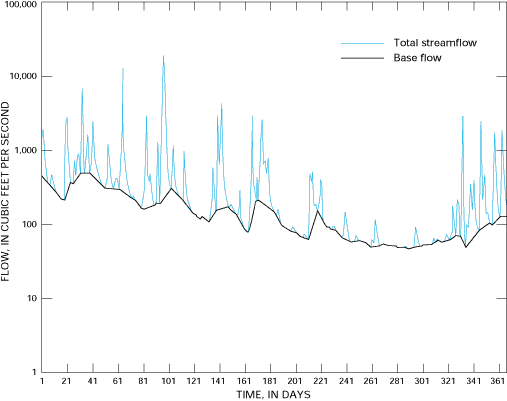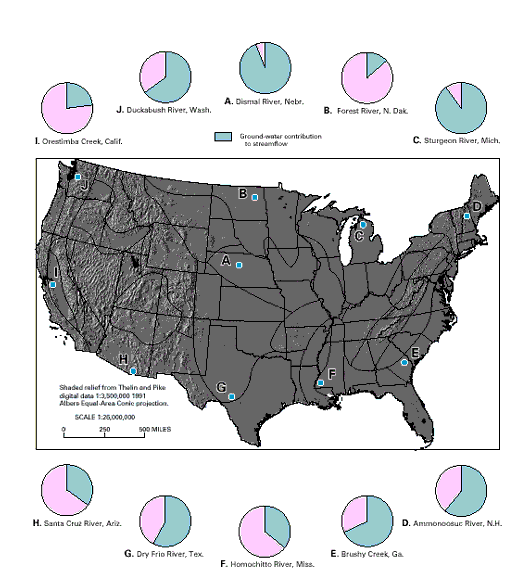B
The Ground-Water Component of Streamflow
Ground water contributes to streams in most physiographic and climatic settings. Even in settings where streams are primarily losing water to ground water, certain reaches may receive ground-water inflow during some seasons. The proportion of stream water that is derived from ground-water inflow varies across physiographic and climatic settings. The amount of water that ground water contributes to streams can be estimated by analyzing streamflow hydrographs to determine the ground-water component, which is termed base flow (Figure B-1). Several different methods of analyzing hydrographs have been used by hydrologists to determine the base-flow component of streamflow.
One of the methods, which provides a conservative estimate of base flow, was used to determine the ground-water contribution to streamflow in 24 regions in the conterminous United States. The regions, delineated on the basis of physiography and climate, are believed to have common characteristics with respect to the interactions of ground water and surface water (Figure B-2). Fifty-four streams were selected for the analysis, at least two in each of the 24 regions. Streams were selected that had drainage basins less than 250 square miles and that had less than 3 percent of the drainage area covered by lakes and wetlands. Daily streamflow values for the 30-year period, 1961-1990, were used for the analysis of each stream. The analysis indicated that, for the 54 streams over the 30-year period, an average of 52 percent of the streamflow was contributed by ground water. Ground-water contributions ranged from 14 percent to 90 percent, and the median was 55 percent. The ground-water contribution to streamflow for selected streams can be compared in Figure B-2. As an example of the effect that geologic setting has on the contribution of ground water to streamflow, the Forest River in North Dakota can be compared to the Sturgeon River in Michigan. The Forest River Basin is underlain by poorly permeable silt and clay deposits, and only about 14 percent of its average annual flow is contributed by ground water; in contrast, the Sturgeon River Basin is underlain by highly permeable sand and gravel, and about 90 percent of its average annual flow is contributed by ground water.
Figure B-1: The ground-water component of streamflow was estimated from a streamflow hydrograph for the Homochitto River in Mississippi, using a method developed by the institute of Hydrology, United Kingdom. (Institute of Hydrology, 1980, Low flow studies: Wallingford, Oxon, United Kingdom, Research Report No. 1.)
Figure B-2: In the conterminous United States, 24 regions were delineated where the interactions of ground water and surface water are considered to have similar characteristics. The estimated ground-water contribution to streamflow is shown for specific streams in 10 of the regions.

